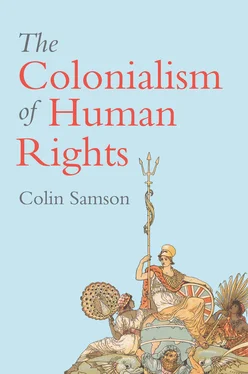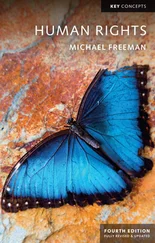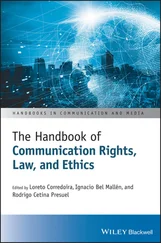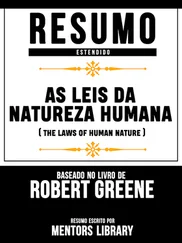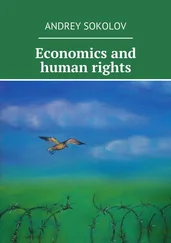Arendt speculates that the alternative to refugee status or rightlessness would be to condemn such people to the status of colonial peoples. 93This, however, was not unthinkable, and is the subject of Mark Mazower’s Hitler’s Empire , in which the historian argues that part of Hitler’s plan was to reproduce the colonial relationships Britain had created outside Europe. The Nazis saw little difference between the racial superiority the British used to justify colonialism and their own variant. ‘The mighty British Empire’, Mazower concludes, ‘had long set the bar for German imperialists’, 94and the Führer was a great admirer of British colonialism. Once refugees were present within nation-states, there were three main options, according to Arendt. Firstly, these populations could be assimilated by re-education and citizenship classes, all of which were intended to cause the disappearance of non-national cultural uniqueness. This became necessary for the maintaining of the national cultural homogeneity, and was, incidentally, already a major policy for indigenous peoples in settler colonial states such as Canada, Australia and the USA. Secondly, they could be deported or forced to migrate, and many did go to the Americas, Australia, Palestine and South Africa; or, thirdly, they could be liquidated, which was the choice of the European fascist regimes that took power in the 1930s. By the end of World War II, as Timothy Snyder has documented, 95German forces had killed about 10 million civilians in mass extermination actions, over half of them Jews. Another 3 million Soviet soldiers died of starvation in German prisoner-of-war camps. The Soviet government killed 15 million Soviet civilians, many of whom were national minorities such as Ukrainians, Kazakhs and Byelorussians, in the 1930s and 1940s. About half a million Germans and Hungarians starved to death while prisoners of the Soviets.
By comparison, ‘civic stratification’ seems tepid, but Arendt shows how ethnic, national or racial differentiations in human rights can become ratcheted up to genocide. If rights become, as they always have been, the enforceable prerogative of the nation, then the kinds of actions undertaken by Nazi Germany and other European states in the 1930s and 1940s to deprive non-nationals of the same rights as the citizen, even though they may have been born in the territory, are always possible. The Third Reich issued mandates by which Jews who left Germany under pressure from pogroms and racial laws, or were deported from it, had no rights of return. The stateless, being rightless, were, as Arendt argues, at the mercy of the police forces, who took it upon themselves to enforce whatever they chose. In fact, the very being of the stateless person was criminalized. They had no rights to work, but, if they did, they were committing a criminal offence. The irony was that only by committing a criminal act could the stateless person gain rights – as a criminal in the state criminal justice system. The paralysing effects of this are described in W. G. Sebald’s Austerlitz , as German decrees on the Jewish Czech population meant that, among other restrictions of her rights, the protagonist’s mother ‘could go shopping only at certain times; she must not take a taxi, she could sit only in the last carriage of the tram, she could not visit a coffeehouse or cinema, or attend a concert or any other event’. 96
If nothing else, Arendt’s ‘The Decline of the Nation-State and the End of the Rights of Man’ points to the dangers of the nation-state being the guarantor of human rights, and here we realize that the abstract ‘Rights of Man’ was a guarantee to individuals only insofar as they were under the protection of the state. The state, as Arendt contends, under its self-asserted sovereignty, is free to act with no recourse to any concept of natural rights. Indeed, as Schmitt argues, states as political entities construct differentiations between internal friend and enemy. 97This means that human rights do not elevate anyone from the condition of ‘bare life’, since rights can be removed at any time, depending on politically concocted human taxonomies. In Agamben’s reading, this precarity of ‘bare life’ is enabled by the French Declaration of Rights itself, which asserts the rights of man and citizens, leaving open the possibility that universal rights are subsumed under citizenship rights, and the sovereign enters into ‘more intimate symbiosis’ with the jurist, doctor scientist, expert and priest. 98Therefore, the sovereign power over the individual is absolute, creating ‘a new living dead man’, 99signifying a major shift, at least in the European world, from earlier, more diverse sources of authority.
Shortly after World War II, under Article 14 of the UDHR, all persons were given the right to seek asylum, and all peoples ‘are equal before the law and are entitled without any discrimination to equal protection of the law’ in Article 7. Subsequent human rights instruments, such as the International Covenant on Civil and Political Rights Article 26, also granted all persons equality before the law, free from discrimination. These enunciations, however, face the contradiction that, while the state was urged to guarantee these rights, it was also the guarantor of national, class, racial and ethnic privileges and inequalities. Indeed, as Arendt recognized, the creation of the state of Israel in British Mandate Palestine in the same year as the UDHR, while providing a ‘homeland’ for Jews, simply created another group of peoples with lesser rights. We know that this situation has continued to the present. 100
Rightlessness and civic stratification are both political processes within states that are regulated by laws, and sometimes even Constitutions. Many years before the European Holocaust, the US Constitution held that black people were outside its reach. African-Americans only became citizens through the 14th Amendment in 1868. This was after the infamous Dred Scott case in 1857, in which a slave kept in non-slave states was ruled not to be a citizen. The first impulse of the US government was to restrict citizenship to Europeans, and this was inscribed in the 1790 Naturalization Act which limited citizenship to ‘white persons’. 101As we will discuss more in chapter 5, a similar ruling in the USA, Lone Wolf v. Hitchcock in 1903, invested Congress with ‘plenary powers’ over Native Americans. 102If people can be classified as not protected by the laws, subject to absolute state authority, outside of any social contract, then anything is possible. Although the victims of rightlessness and inferior rights have fought back through social movements, organized acts of resistance, oratory and art, their effects on a wide range of groups today cannot be overestimated.
The Structural Embeddedness of Non-universal Human Rights
Both an antecedent and continuing dynamic, hierarchical comparison of cultures has underpinned hierarchies of rights. Dehumanizing images and practices, scientific racism, cultural evolutionism, intelligence tests and paternal tutelage were all widely espoused by liberals to rank human communities. Hence, human rights arrived within a liberal world that had already constructed numerous concepts of invidious human difference. Decolonization and the UDHR did not lead to reflection on how these concepts could be challenged and colonizing could be avoided, but to a kind of triumphalism that heralded a new international order based more on peace, cooperation and economic development. Buzan and Lawson maintain of the post-World War II international society that, while ‘many status inequalities lingered on … the package of colonialism, human inequality/racism, the “standard of civilization” and divided sovereignty unravelled’. 103In its place, a ‘new package’ consisting of universal human rights, anti-racism and aspirations to equality was said to prevail.
Читать дальше
